Implementing Positive Interventions for Depressed Employees
VerifiedAdded on 2020/04/15
|7
|1811
|274
AI Summary
The document provides an insightful analysis of handling workplace depression from a managerial perspective. It emphasizes understanding employee resistance to feedback and outlines practical measures such as group interventions and regular performance checks. The importance of fostering a supportive work environment is highlighted, with strategies like setting daily routines and engaging in new activities for employees dealing with depression. References include works on stress management and mental illness in the workplace, offering comprehensive guidance on promoting organizational wellness and employee well-being.
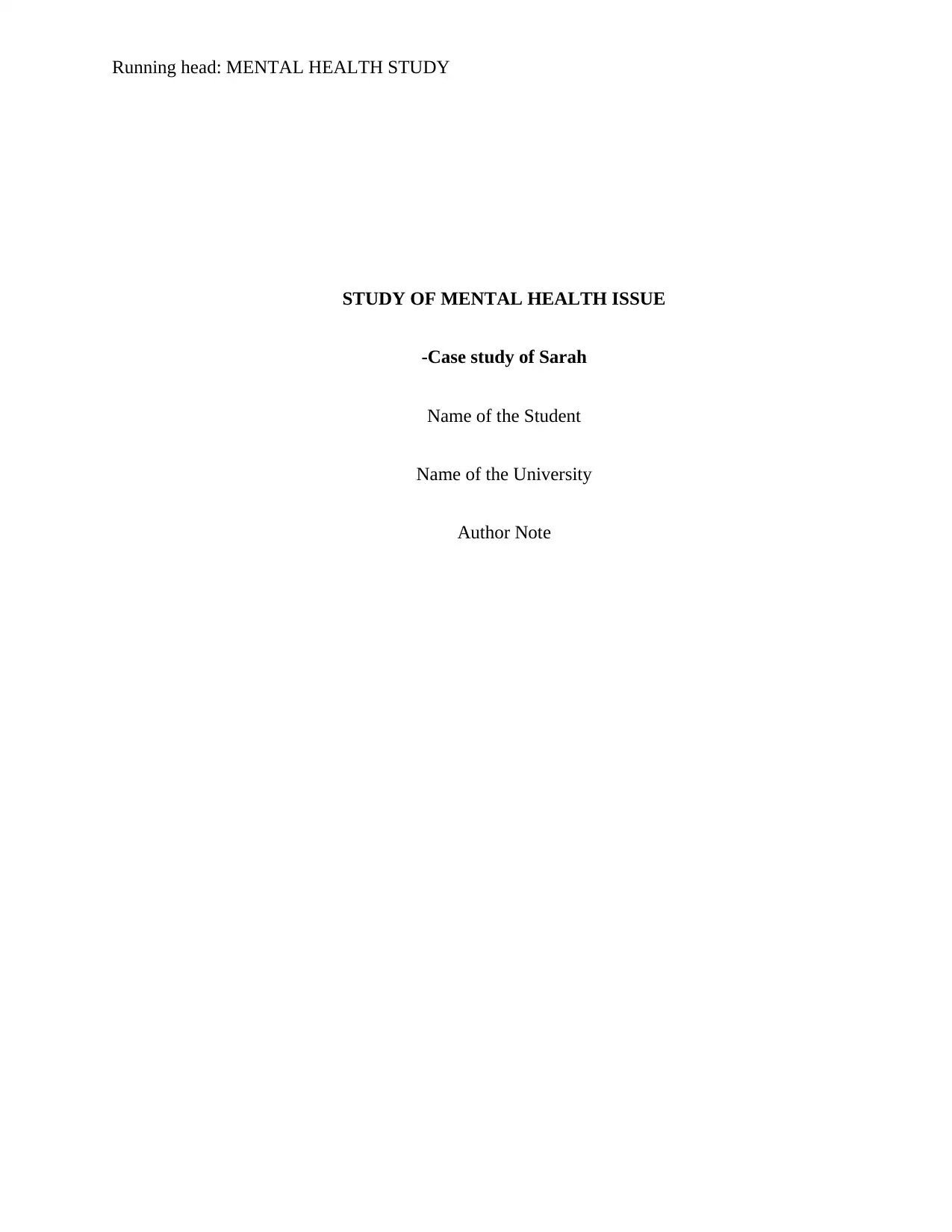
Running head: MENTAL HEALTH STUDY
STUDY OF MENTAL HEALTH ISSUE
-Case study of Sarah
Name of the Student
Name of the University
Author Note
STUDY OF MENTAL HEALTH ISSUE
-Case study of Sarah
Name of the Student
Name of the University
Author Note
Paraphrase This Document
Need a fresh take? Get an instant paraphrase of this document with our AI Paraphraser
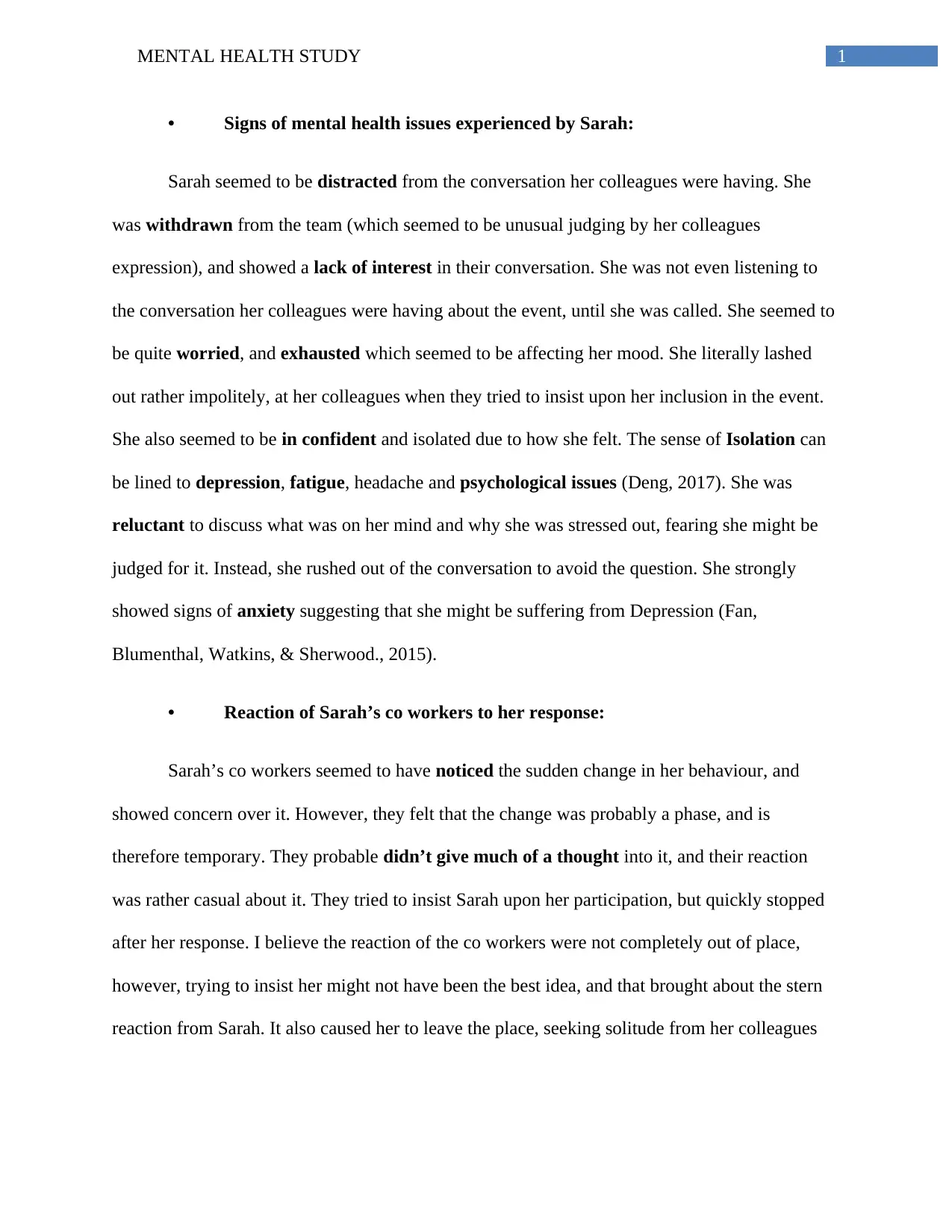
1MENTAL HEALTH STUDY
• Signs of mental health issues experienced by Sarah:
Sarah seemed to be distracted from the conversation her colleagues were having. She
was withdrawn from the team (which seemed to be unusual judging by her colleagues
expression), and showed a lack of interest in their conversation. She was not even listening to
the conversation her colleagues were having about the event, until she was called. She seemed to
be quite worried, and exhausted which seemed to be affecting her mood. She literally lashed
out rather impolitely, at her colleagues when they tried to insist upon her inclusion in the event.
She also seemed to be in confident and isolated due to how she felt. The sense of Isolation can
be lined to depression, fatigue, headache and psychological issues (Deng, 2017). She was
reluctant to discuss what was on her mind and why she was stressed out, fearing she might be
judged for it. Instead, she rushed out of the conversation to avoid the question. She strongly
showed signs of anxiety suggesting that she might be suffering from Depression (Fan,
Blumenthal, Watkins, & Sherwood., 2015).
• Reaction of Sarah’s co workers to her response:
Sarah’s co workers seemed to have noticed the sudden change in her behaviour, and
showed concern over it. However, they felt that the change was probably a phase, and is
therefore temporary. They probable didn’t give much of a thought into it, and their reaction
was rather casual about it. They tried to insist Sarah upon her participation, but quickly stopped
after her response. I believe the reaction of the co workers were not completely out of place,
however, trying to insist her might not have been the best idea, and that brought about the stern
reaction from Sarah. It also caused her to leave the place, seeking solitude from her colleagues
• Signs of mental health issues experienced by Sarah:
Sarah seemed to be distracted from the conversation her colleagues were having. She
was withdrawn from the team (which seemed to be unusual judging by her colleagues
expression), and showed a lack of interest in their conversation. She was not even listening to
the conversation her colleagues were having about the event, until she was called. She seemed to
be quite worried, and exhausted which seemed to be affecting her mood. She literally lashed
out rather impolitely, at her colleagues when they tried to insist upon her inclusion in the event.
She also seemed to be in confident and isolated due to how she felt. The sense of Isolation can
be lined to depression, fatigue, headache and psychological issues (Deng, 2017). She was
reluctant to discuss what was on her mind and why she was stressed out, fearing she might be
judged for it. Instead, she rushed out of the conversation to avoid the question. She strongly
showed signs of anxiety suggesting that she might be suffering from Depression (Fan,
Blumenthal, Watkins, & Sherwood., 2015).
• Reaction of Sarah’s co workers to her response:
Sarah’s co workers seemed to have noticed the sudden change in her behaviour, and
showed concern over it. However, they felt that the change was probably a phase, and is
therefore temporary. They probable didn’t give much of a thought into it, and their reaction
was rather casual about it. They tried to insist Sarah upon her participation, but quickly stopped
after her response. I believe the reaction of the co workers were not completely out of place,
however, trying to insist her might not have been the best idea, and that brought about the stern
reaction from Sarah. It also caused her to leave the place, seeking solitude from her colleagues
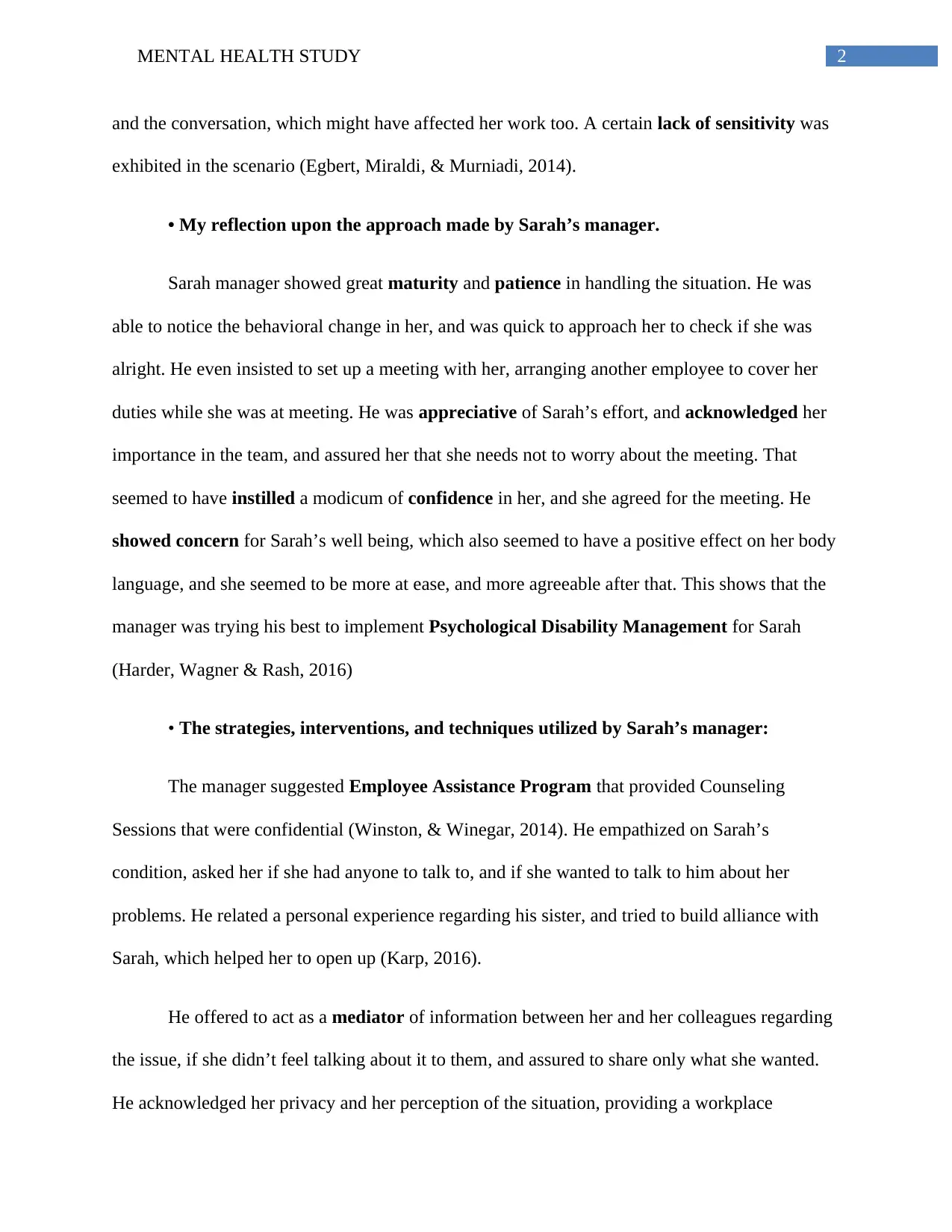
2MENTAL HEALTH STUDY
and the conversation, which might have affected her work too. A certain lack of sensitivity was
exhibited in the scenario (Egbert, Miraldi, & Murniadi, 2014).
• My reflection upon the approach made by Sarah’s manager.
Sarah manager showed great maturity and patience in handling the situation. He was
able to notice the behavioral change in her, and was quick to approach her to check if she was
alright. He even insisted to set up a meeting with her, arranging another employee to cover her
duties while she was at meeting. He was appreciative of Sarah’s effort, and acknowledged her
importance in the team, and assured her that she needs not to worry about the meeting. That
seemed to have instilled a modicum of confidence in her, and she agreed for the meeting. He
showed concern for Sarah’s well being, which also seemed to have a positive effect on her body
language, and she seemed to be more at ease, and more agreeable after that. This shows that the
manager was trying his best to implement Psychological Disability Management for Sarah
(Harder, Wagner & Rash, 2016)
• The strategies, interventions, and techniques utilized by Sarah’s manager:
The manager suggested Employee Assistance Program that provided Counseling
Sessions that were confidential (Winston, & Winegar, 2014). He empathized on Sarah’s
condition, asked her if she had anyone to talk to, and if she wanted to talk to him about her
problems. He related a personal experience regarding his sister, and tried to build alliance with
Sarah, which helped her to open up (Karp, 2016).
He offered to act as a mediator of information between her and her colleagues regarding
the issue, if she didn’t feel talking about it to them, and assured to share only what she wanted.
He acknowledged her privacy and her perception of the situation, providing a workplace
and the conversation, which might have affected her work too. A certain lack of sensitivity was
exhibited in the scenario (Egbert, Miraldi, & Murniadi, 2014).
• My reflection upon the approach made by Sarah’s manager.
Sarah manager showed great maturity and patience in handling the situation. He was
able to notice the behavioral change in her, and was quick to approach her to check if she was
alright. He even insisted to set up a meeting with her, arranging another employee to cover her
duties while she was at meeting. He was appreciative of Sarah’s effort, and acknowledged her
importance in the team, and assured her that she needs not to worry about the meeting. That
seemed to have instilled a modicum of confidence in her, and she agreed for the meeting. He
showed concern for Sarah’s well being, which also seemed to have a positive effect on her body
language, and she seemed to be more at ease, and more agreeable after that. This shows that the
manager was trying his best to implement Psychological Disability Management for Sarah
(Harder, Wagner & Rash, 2016)
• The strategies, interventions, and techniques utilized by Sarah’s manager:
The manager suggested Employee Assistance Program that provided Counseling
Sessions that were confidential (Winston, & Winegar, 2014). He empathized on Sarah’s
condition, asked her if she had anyone to talk to, and if she wanted to talk to him about her
problems. He related a personal experience regarding his sister, and tried to build alliance with
Sarah, which helped her to open up (Karp, 2016).
He offered to act as a mediator of information between her and her colleagues regarding
the issue, if she didn’t feel talking about it to them, and assured to share only what she wanted.
He acknowledged her privacy and her perception of the situation, providing a workplace
⊘ This is a preview!⊘
Do you want full access?
Subscribe today to unlock all pages.

Trusted by 1+ million students worldwide
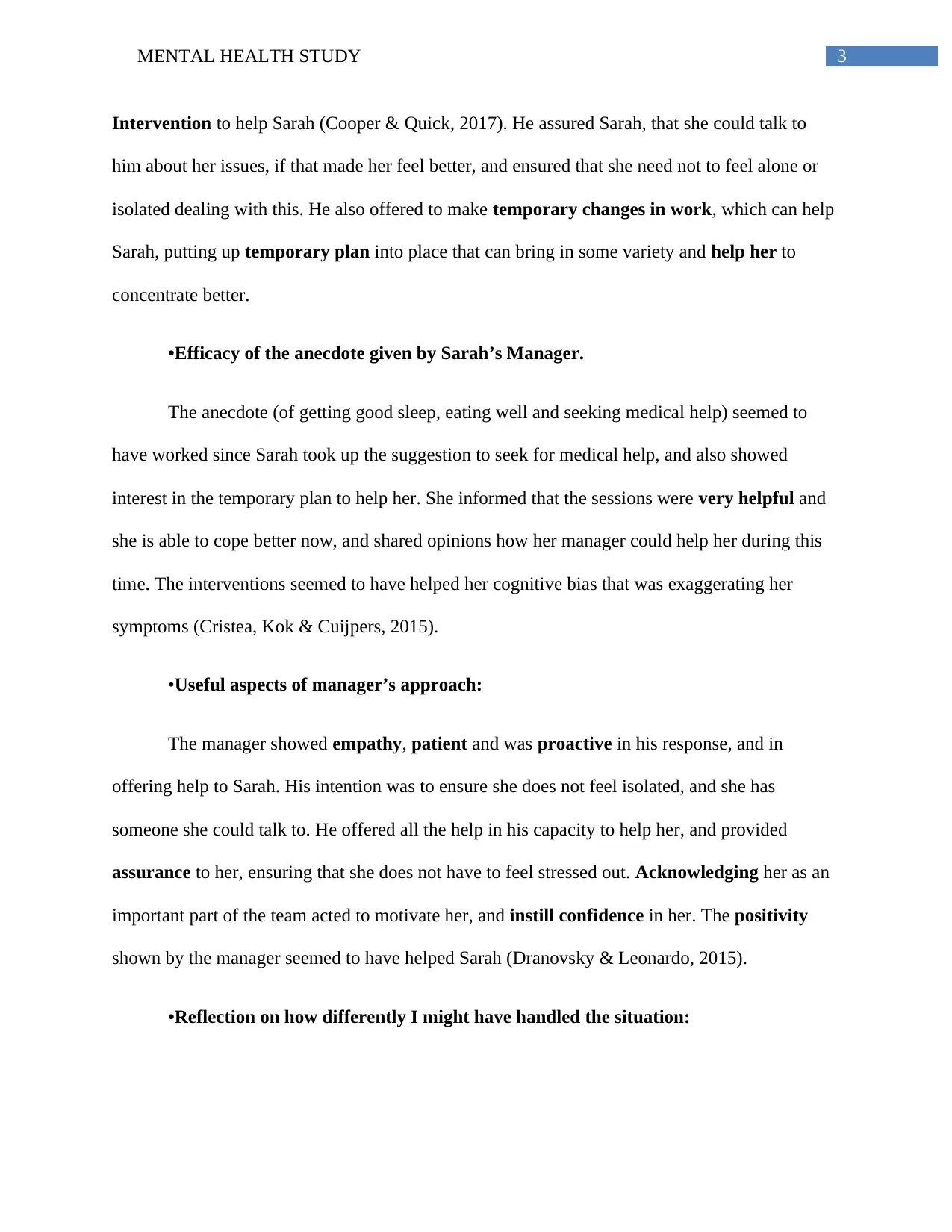
3MENTAL HEALTH STUDY
Intervention to help Sarah (Cooper & Quick, 2017). He assured Sarah, that she could talk to
him about her issues, if that made her feel better, and ensured that she need not to feel alone or
isolated dealing with this. He also offered to make temporary changes in work, which can help
Sarah, putting up temporary plan into place that can bring in some variety and help her to
concentrate better.
•Efficacy of the anecdote given by Sarah’s Manager.
The anecdote (of getting good sleep, eating well and seeking medical help) seemed to
have worked since Sarah took up the suggestion to seek for medical help, and also showed
interest in the temporary plan to help her. She informed that the sessions were very helpful and
she is able to cope better now, and shared opinions how her manager could help her during this
time. The interventions seemed to have helped her cognitive bias that was exaggerating her
symptoms (Cristea, Kok & Cuijpers, 2015).
•Useful aspects of manager’s approach:
The manager showed empathy, patient and was proactive in his response, and in
offering help to Sarah. His intention was to ensure she does not feel isolated, and she has
someone she could talk to. He offered all the help in his capacity to help her, and provided
assurance to her, ensuring that she does not have to feel stressed out. Acknowledging her as an
important part of the team acted to motivate her, and instill confidence in her. The positivity
shown by the manager seemed to have helped Sarah (Dranovsky & Leonardo, 2015).
•Reflection on how differently I might have handled the situation:
Intervention to help Sarah (Cooper & Quick, 2017). He assured Sarah, that she could talk to
him about her issues, if that made her feel better, and ensured that she need not to feel alone or
isolated dealing with this. He also offered to make temporary changes in work, which can help
Sarah, putting up temporary plan into place that can bring in some variety and help her to
concentrate better.
•Efficacy of the anecdote given by Sarah’s Manager.
The anecdote (of getting good sleep, eating well and seeking medical help) seemed to
have worked since Sarah took up the suggestion to seek for medical help, and also showed
interest in the temporary plan to help her. She informed that the sessions were very helpful and
she is able to cope better now, and shared opinions how her manager could help her during this
time. The interventions seemed to have helped her cognitive bias that was exaggerating her
symptoms (Cristea, Kok & Cuijpers, 2015).
•Useful aspects of manager’s approach:
The manager showed empathy, patient and was proactive in his response, and in
offering help to Sarah. His intention was to ensure she does not feel isolated, and she has
someone she could talk to. He offered all the help in his capacity to help her, and provided
assurance to her, ensuring that she does not have to feel stressed out. Acknowledging her as an
important part of the team acted to motivate her, and instill confidence in her. The positivity
shown by the manager seemed to have helped Sarah (Dranovsky & Leonardo, 2015).
•Reflection on how differently I might have handled the situation:
Paraphrase This Document
Need a fresh take? Get an instant paraphrase of this document with our AI Paraphraser
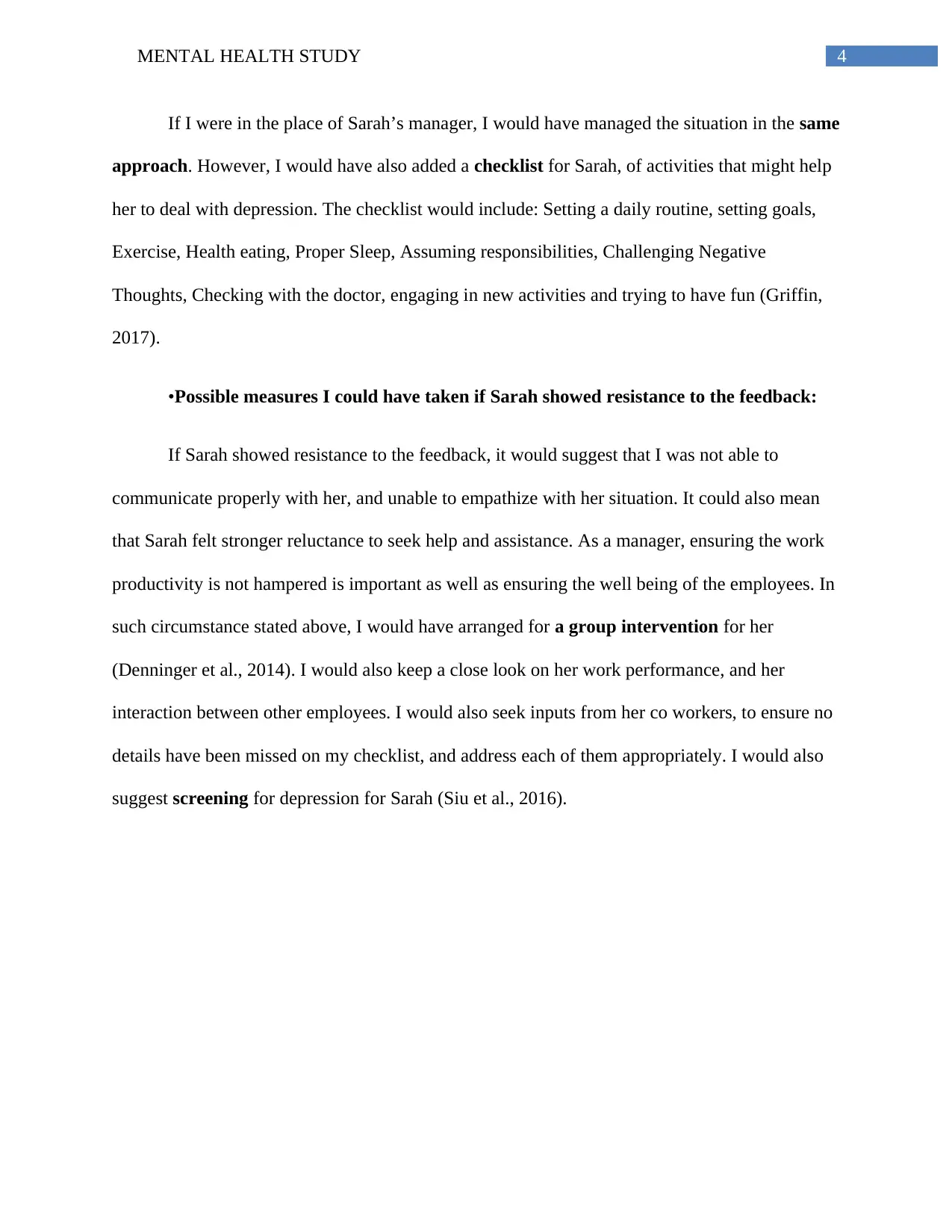
4MENTAL HEALTH STUDY
If I were in the place of Sarah’s manager, I would have managed the situation in the same
approach. However, I would have also added a checklist for Sarah, of activities that might help
her to deal with depression. The checklist would include: Setting a daily routine, setting goals,
Exercise, Health eating, Proper Sleep, Assuming responsibilities, Challenging Negative
Thoughts, Checking with the doctor, engaging in new activities and trying to have fun (Griffin,
2017).
•Possible measures I could have taken if Sarah showed resistance to the feedback:
If Sarah showed resistance to the feedback, it would suggest that I was not able to
communicate properly with her, and unable to empathize with her situation. It could also mean
that Sarah felt stronger reluctance to seek help and assistance. As a manager, ensuring the work
productivity is not hampered is important as well as ensuring the well being of the employees. In
such circumstance stated above, I would have arranged for a group intervention for her
(Denninger et al., 2014). I would also keep a close look on her work performance, and her
interaction between other employees. I would also seek inputs from her co workers, to ensure no
details have been missed on my checklist, and address each of them appropriately. I would also
suggest screening for depression for Sarah (Siu et al., 2016).
If I were in the place of Sarah’s manager, I would have managed the situation in the same
approach. However, I would have also added a checklist for Sarah, of activities that might help
her to deal with depression. The checklist would include: Setting a daily routine, setting goals,
Exercise, Health eating, Proper Sleep, Assuming responsibilities, Challenging Negative
Thoughts, Checking with the doctor, engaging in new activities and trying to have fun (Griffin,
2017).
•Possible measures I could have taken if Sarah showed resistance to the feedback:
If Sarah showed resistance to the feedback, it would suggest that I was not able to
communicate properly with her, and unable to empathize with her situation. It could also mean
that Sarah felt stronger reluctance to seek help and assistance. As a manager, ensuring the work
productivity is not hampered is important as well as ensuring the well being of the employees. In
such circumstance stated above, I would have arranged for a group intervention for her
(Denninger et al., 2014). I would also keep a close look on her work performance, and her
interaction between other employees. I would also seek inputs from her co workers, to ensure no
details have been missed on my checklist, and address each of them appropriately. I would also
suggest screening for depression for Sarah (Siu et al., 2016).
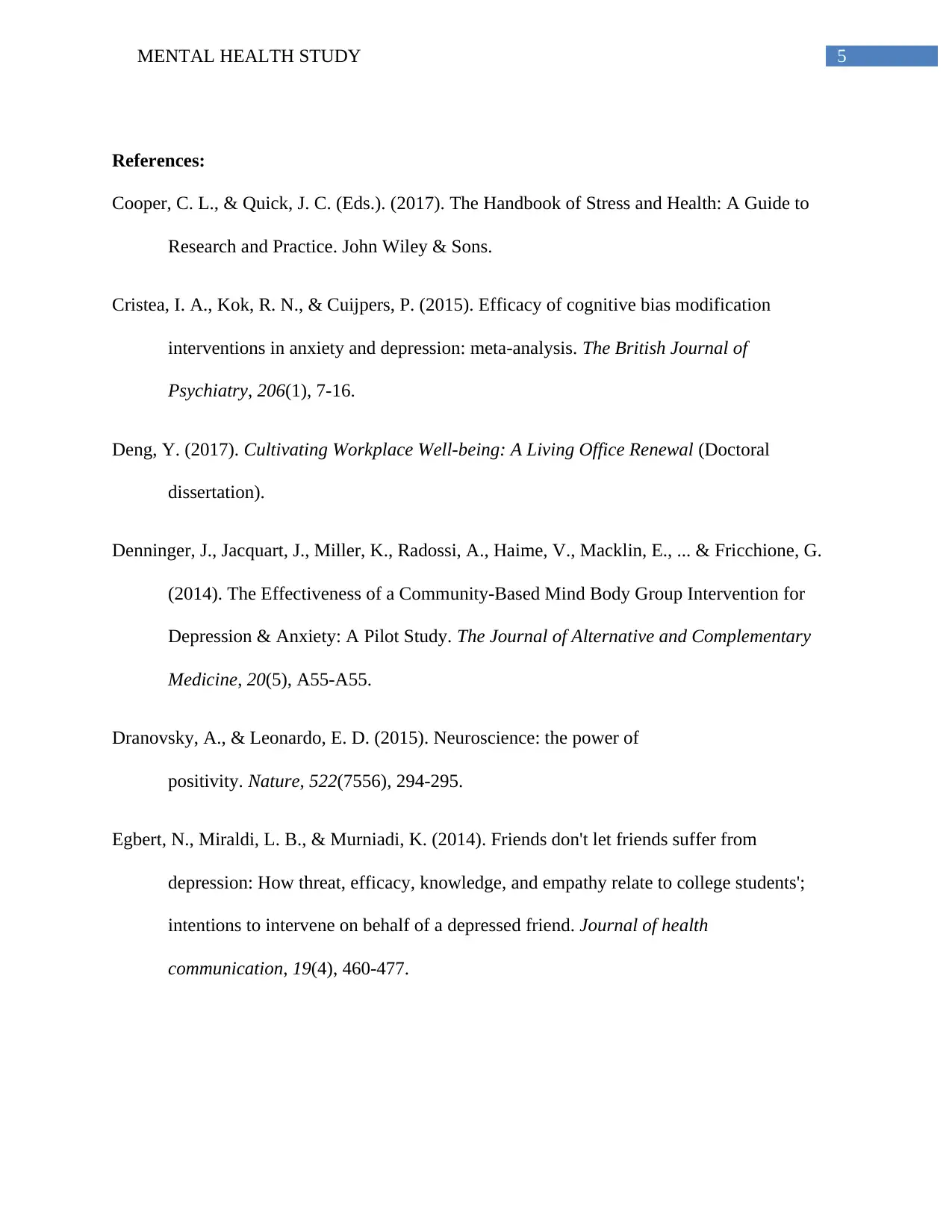
5MENTAL HEALTH STUDY
References:
Cooper, C. L., & Quick, J. C. (Eds.). (2017). The Handbook of Stress and Health: A Guide to
Research and Practice. John Wiley & Sons.
Cristea, I. A., Kok, R. N., & Cuijpers, P. (2015). Efficacy of cognitive bias modification
interventions in anxiety and depression: meta-analysis. The British Journal of
Psychiatry, 206(1), 7-16.
Deng, Y. (2017). Cultivating Workplace Well-being: A Living Office Renewal (Doctoral
dissertation).
Denninger, J., Jacquart, J., Miller, K., Radossi, A., Haime, V., Macklin, E., ... & Fricchione, G.
(2014). The Effectiveness of a Community-Based Mind Body Group Intervention for
Depression & Anxiety: A Pilot Study. The Journal of Alternative and Complementary
Medicine, 20(5), A55-A55.
Dranovsky, A., & Leonardo, E. D. (2015). Neuroscience: the power of
positivity. Nature, 522(7556), 294-295.
Egbert, N., Miraldi, L. B., & Murniadi, K. (2014). Friends don't let friends suffer from
depression: How threat, efficacy, knowledge, and empathy relate to college students';
intentions to intervene on behalf of a depressed friend. Journal of health
communication, 19(4), 460-477.
References:
Cooper, C. L., & Quick, J. C. (Eds.). (2017). The Handbook of Stress and Health: A Guide to
Research and Practice. John Wiley & Sons.
Cristea, I. A., Kok, R. N., & Cuijpers, P. (2015). Efficacy of cognitive bias modification
interventions in anxiety and depression: meta-analysis. The British Journal of
Psychiatry, 206(1), 7-16.
Deng, Y. (2017). Cultivating Workplace Well-being: A Living Office Renewal (Doctoral
dissertation).
Denninger, J., Jacquart, J., Miller, K., Radossi, A., Haime, V., Macklin, E., ... & Fricchione, G.
(2014). The Effectiveness of a Community-Based Mind Body Group Intervention for
Depression & Anxiety: A Pilot Study. The Journal of Alternative and Complementary
Medicine, 20(5), A55-A55.
Dranovsky, A., & Leonardo, E. D. (2015). Neuroscience: the power of
positivity. Nature, 522(7556), 294-295.
Egbert, N., Miraldi, L. B., & Murniadi, K. (2014). Friends don't let friends suffer from
depression: How threat, efficacy, knowledge, and empathy relate to college students';
intentions to intervene on behalf of a depressed friend. Journal of health
communication, 19(4), 460-477.
⊘ This is a preview!⊘
Do you want full access?
Subscribe today to unlock all pages.

Trusted by 1+ million students worldwide
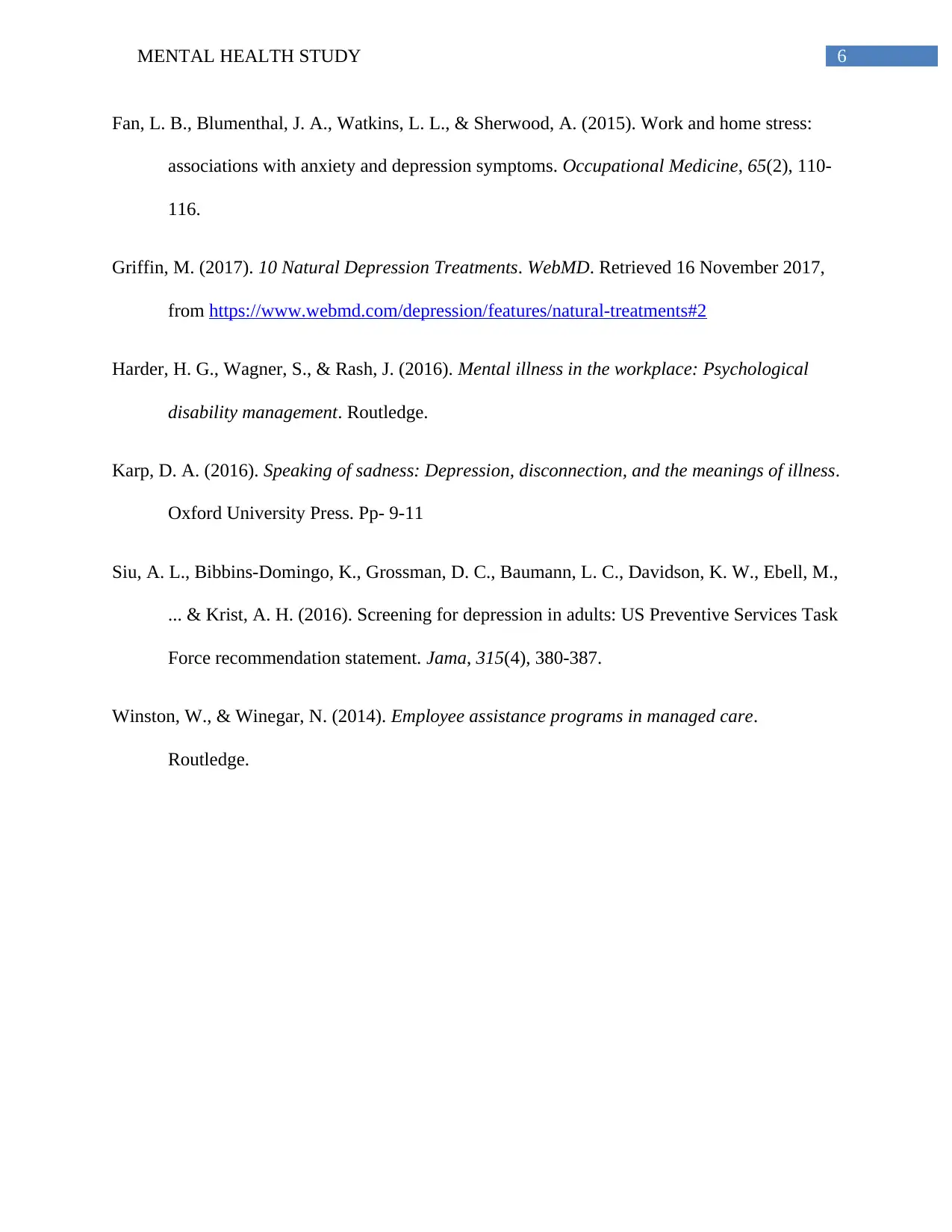
6MENTAL HEALTH STUDY
Fan, L. B., Blumenthal, J. A., Watkins, L. L., & Sherwood, A. (2015). Work and home stress:
associations with anxiety and depression symptoms. Occupational Medicine, 65(2), 110-
116.
Griffin, M. (2017). 10 Natural Depression Treatments. WebMD. Retrieved 16 November 2017,
from https://www.webmd.com/depression/features/natural-treatments#2
Harder, H. G., Wagner, S., & Rash, J. (2016). Mental illness in the workplace: Psychological
disability management. Routledge.
Karp, D. A. (2016). Speaking of sadness: Depression, disconnection, and the meanings of illness.
Oxford University Press. Pp- 9-11
Siu, A. L., Bibbins-Domingo, K., Grossman, D. C., Baumann, L. C., Davidson, K. W., Ebell, M.,
... & Krist, A. H. (2016). Screening for depression in adults: US Preventive Services Task
Force recommendation statement. Jama, 315(4), 380-387.
Winston, W., & Winegar, N. (2014). Employee assistance programs in managed care.
Routledge.
Fan, L. B., Blumenthal, J. A., Watkins, L. L., & Sherwood, A. (2015). Work and home stress:
associations with anxiety and depression symptoms. Occupational Medicine, 65(2), 110-
116.
Griffin, M. (2017). 10 Natural Depression Treatments. WebMD. Retrieved 16 November 2017,
from https://www.webmd.com/depression/features/natural-treatments#2
Harder, H. G., Wagner, S., & Rash, J. (2016). Mental illness in the workplace: Psychological
disability management. Routledge.
Karp, D. A. (2016). Speaking of sadness: Depression, disconnection, and the meanings of illness.
Oxford University Press. Pp- 9-11
Siu, A. L., Bibbins-Domingo, K., Grossman, D. C., Baumann, L. C., Davidson, K. W., Ebell, M.,
... & Krist, A. H. (2016). Screening for depression in adults: US Preventive Services Task
Force recommendation statement. Jama, 315(4), 380-387.
Winston, W., & Winegar, N. (2014). Employee assistance programs in managed care.
Routledge.
1 out of 7
Related Documents
Your All-in-One AI-Powered Toolkit for Academic Success.
+13062052269
info@desklib.com
Available 24*7 on WhatsApp / Email
![[object Object]](/_next/static/media/star-bottom.7253800d.svg)
Unlock your academic potential
Copyright © 2020–2025 A2Z Services. All Rights Reserved. Developed and managed by ZUCOL.




